Share
PhotoShelter Staff Beam Portfolios: Senior Manager of QA Michael Treola
A past as a professional photojournalist mixed with a present love for all things photography make our Senior Manager of Quality Assurance, Michael...

A past as a professional photojournalist mixed with a present love for all things photography make our Senior Manager of Quality Assurance, Michael Treola, one great candidate for PhotoShelter bug-catching. Tree (as we all know him) was kind enough to stop trying to break things for a few minutes to talk to us about how he uses Beam to display his portfolio, and why his passion for photography in general has been strong since he was a just a wee one…. plus get a sneak peek of what he and the rest of the QA team are working on now.
Tell us a little about your role with PhotoShelter.
My official title is Senior Manager of Quality Assurance. In layman’s terms, I am the head bug catcher here at PhotoShelter. My team’s job is to root out the bugs in the system before they find you. It’s an incredibly challenging job where you need to have a systematic approach and thorough testing formulas. You must also flip that same methodology upside down and test as you would think a photographer might use the system. With photographers having a million and one individual workflows, covering all the ways a photographer uses PhotoShelter is a challenging task. This is what makes the job fun. Who else gets paid to try and break things at work?
How’d you get this job? And why do you love it?
I came to work at PhotoShelter after many years as a staff photojournalist at a major New Jersey newspaper. It’s no secret the newspaper business is amid a downturn where layoffs dominate the news more than the news itself, it seems. I was smart enough to see this cycle happening before it was too late. It was clear back then my job and livelihood were in jeopardy, maybe not right at that moment, but the financial instability of the news business was clear and I was going to be proactive and find a new career path.
During this time I was (and still am) an administrator at SportsShooter.com. In discussions with the owners here I learned of plans to spin up this new venture called PhotoShelter. Not too long after PhotoShelter was born I was doing contract work for them and formally became PhotoShelter Employee #10 about a year later.
Fast forward 8 years later, my time here at PhotoShelter has been a rewarding one. Not only have I been able to follow my passion for photography, I am able to do so on an advanced technical level, which is so necessary in the very digital centric world we live in. I truly learn something new every day and actually enjoy coming to work.
I also happen to work for an incredibly talented group of people, many of whom are so forward thinking it blows my mind. Our team is always pushing the envelope in the photo space and that makes working here a blast. Every day something new is arriving to be tested that makes our product better, not only for our members but for the photography world, as well. It’s nice to feel a part of something that truly helps the photography community on so many levels.
Do you still think of yourself as a “pro” photographer?
Even though my primary income is no longer from being a photographer directly, I do still very much consider myself a “professional.” I am a fully equipped Canon shooter with lenses from 16mm to 400mm. I have more lighting equipment then I know what to do with. It’s not and never has been about the equipment, though! The most important thing is that I can and still see, compose, and execute the image in front of me with the same abilities as I had when I was a working pro. I don’t think this gift ever goes away even if you’re not in the game full time. Sure you might get rusty, but when you are a “shooter” it’s in your blood and your ability to create images comes naturally.
Can you give me a little history around your love for photography?
How I ended up where I am photographically dates back to my youth. I was maybe 8 or 9 when I first laid my eyes on the Minolta SRT 201. A good family friend owned this silver, big, flashy, and complicated looking “thing.” The camera also featured a Metz “potato masher” flash that I thought was the coolest thing ever. This friend always had his camera at big events and I found myself glued to what he was doing with it. I still remember that camera like it was yesterday.
It’s because of these experiences and wanting to be like him that I bought my first camera. This turned out to be a very basic Minolta 5000i and a 50mm prime – I was off and running. Years later, seeing my craft and creativity grow, I “upgraded” to a fully manual Nikon F3. This is really where I learned the mechanics of good photography. From there I progressed as many “pros” did by having F4, F4s and then F5. During the Nikon “F” years I was deep in my photojournalism career at the newspaper. Eventually the newspaper outfitted us with one of the first real digital cameras catered to pros. It was a Kodak/Canon DCS520 – and what a frustrating tank that camera was! It was pretty much this camera that started the digital revolution on a grand scale, and good grief has it moved quickly ever since.
Can you talk about your photojournalism work specifically?
My responsibilities at the newspaper ran the full gamut of what a working PJ would experience. I’d be assigned to community photojournalism, breaking and national news stories, photo essays, weather, spot news, and sports events ranging from little league to professional sports. I had the pleasure of shooting it all and have more stories to tell then we have space.
Ask any photojournalist and they will say their job is a truly rewarding experience. I was granted, on a regular basis, a behind the scenes look at the world around us. Many times I was invited into the lives of people going through truly emotional and heart breaking events. Witnessing the courage of those who allowed their story to be told is incredibly humbling and something I took very seriously.
Today my photo life is different and focuses on mainly stock photography of the New Jersey Shore region. I shoot on my terms and without rules, which makes exploring photography outside photojournalism, the only kind of photography I ever really knew to this point, an eye opening experience. After all these years I still have a ton of passion for photography… mine and yours!
Moving on to Beam… Tell us about why you chose the template and design you’re using.
I am using the Marquee theme to showcase my portfolio. The final selling point for Marquee for me was the “in your face” style of the full bleed cover images. If you choose these cover images perfectly, you create the “wow” factor that sets your work apart from your competition. I also like easy access to the galleries I feature from the hover menu at right. So a visitor can quickly see what I’m about without having to hunt around to understand my style and that’s an important requirement in my opinion.
And how has it been to manage the QA of the new platform?
The introduction of Beam was a giant step forward for PhotoShelter because it advanced our offering in a space that’s increasingly dominated by tablet and mobile computing. We now have the ability to effectively present our product on these devices and do so in an impactful way where design hits our presentation out of the park.
But that said, bug testing the Beam sites definitely introduced a new set of challenges. Not only does the QA team have to verify that Beam works well on the desktop, we needed to cross test Beam on the various Android and iDevices in circulation today. Monitoring our site analytics we have a good understanding of what mobile and tablet hardware our visitors use. This weighs greatly on how and with what devices we test. As is the nature of the mobile space, testing is a very hands on affair. Very little can be automated because these devices require human interaction to scroll, swipe or touch, and so forth. As such, the testing approach can sometimes be slow, tedious, and require careful attention, but the outcome (when it all comes together) is a product that works like a charm, is fun to use, and is well executed.
Can you tell us anything about what’s currently on your QA plate?
I am currently testing a project that offers the development team the ability to store different versions of your Beam theme configurations. What this means for you is that as we release new site features, you’ll now have the ability to opt into the new offering or you can leave your site in its current form. The beauty is your site will no longer be forcefully upgraded with many more capabilities outside this. We’ll be rolling this out soon and already have plans to bake in this feature with new site updates.
Behind this there’s always a bunch of really cool stuff, but I’d have to kill you if I told you!
Anything new in your photography world outside the office?
When I am not photographing my beautiful girlfriend, I am just shooting what I see around me. I always have a camera. While I don’t have a specific project in motion, I am always working at being a photographer. When it comes to photography, trying new things and exploring this personal vision of mine is just “in me” and something I get a great amount of personal enjoyment from and I hope that never changes.
Thank you all for listening and I hope you enjoy my site.
See Michael Treola’s Beam site here.









